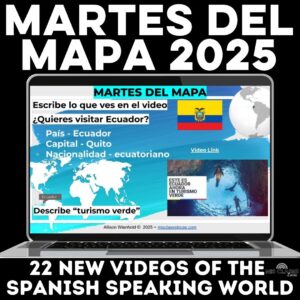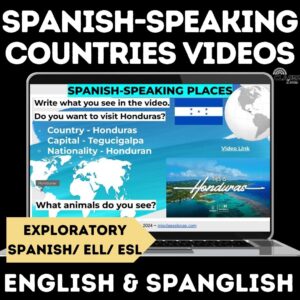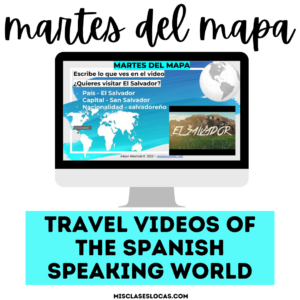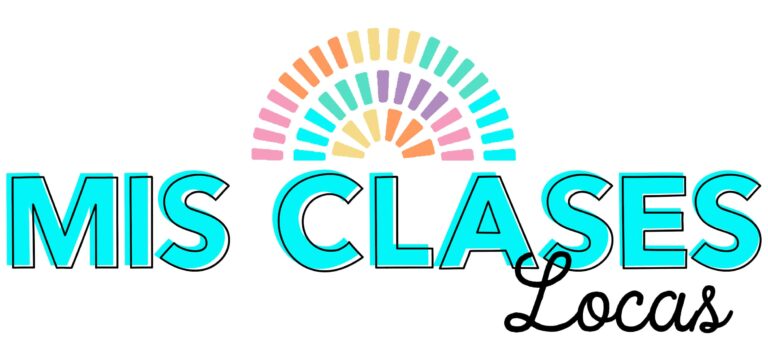Inside: Teaching students about the diverse Spanish-speaking countries of the world is an important part of any Spanish class. Learning about the world takes Spanish classes beyond just the Spanish language. It goes deeper into the diverse cultures and people that speak this vibrant language.
Author – Allison Wienhold
Published – January 9, 2023 & most recently updated January 22, 2025

Why is it important to learn about Spanish-speaking countries of the world?
Story time. While in graduate school I found out that I get to spend my summer living and volunteering in Rota, Spain. My then-boyfriend (& now husband) mentioned how he was going to miss me while I was living in South America. Umm, what?
This was an educated man, who actually took two years of high school Spanish.
He had gone months not realizing I was actually going to be living in Europe, not Latin America. He mentioned that his Spanish class was mostly memorizing verbs and vocab. They never really talked about any culture or who speaks Spanish in the world.
We have to remember that communication is just one of the five core ACTFL World-Readiness Standards. It also includes cultures, comparisons, connections, and communities.
Maps of Spanish-Speaking Countries
I am a long-time lover of geography. (I made it to the schoolwide 5th-grade geography bee:). Even though I had never left the country, I was fascinated by learning about far-off places and people.
So my Spanish classroom had many maps of Spanish-speaking places on the walls. Beyond the world map I was given as a graduation present for my classroom, I had many other old National Geographic Maps that I scored from the school library where I student taught. This included a map of the predominantly Spanish-speaking Central America and the Caribbean, South America, and Spain. (You can see them displayed in my former Spanish Classroom).
Beyond just introducing and teaching the countries that speak Spanish in the world, I referenced places on these maps by pointing daily. I laminated the free National Geographic maps to keep the up all year. While older and not exactly accurate if you looked up close, from farther away they helped to visually show where each place we were learning about was located in the world.
It was important to me to show students that there was a world outside of their tiny, rural, midwest USA bubble
Flags for Spanish-Speaking countries
Also, images of flags from each country can provide context and create interest for some students. For example, during the Copa Mundial or Olympics flags of the teams included were displayed often, and students began to recognize them.
Do I think it is important or needed to memorize or be able to label the flags of Spanish-speaking places? No. Can you use flags as decoration or to teach colors &/or shapes in Spanish with a cultural context? Absolutely.
If it came down to teaching flags or geography, where the Spanish-speaking places are located in the world would for sure be of higher importance in my opinion. My martes del mapa resource includes a flag for each Spanish-speaking place. (Get it in my shop)
Spanish-Speaking Countries – How to go beyond the surface level
Many traditional methods just teaching Spanish countries and capitals by memorizing flags or a map to label can be tedious and surface level. Believe me, I started every single level in my first year of teaching with a traditional map of Spanish-speaking countries and capitals unit. We sang the annoying country song, and then did basic memorization and recall with label the Spanish-speaking map quiz on Friday.
You can see more about that Spanish Speaking Countries unit in this blog post.
Did a few kids retain that information and let me know they learned more about geography in my class than social studies? Yes. Did we really go deeper with the culture that year beyond just the surface-level locations of places? No.
Spanish Culture as the Core
Since then I have really shifted my views on teaching culture, to centering my curriculum on culture-rich units. If you are required to “teach the Spanish-speaking countries,” I have found that travel videos in Spanish and music of the Spanish-speaking world offer a unique opportunity to teach Spanish-speaking countries of the world in a more engaging way.
I am going to focus more on travel videos in this post. If you want to learn more about my one song from each Spanish-speaking country music bracket for Hispanic Heritage Month, read this blog post.

Travel Videos to Teach Spanish-Speaking Countries
First, let’s explore how music and travel videos in Spanish can be used to deepen students’ study of Spanish-speaking countries. Here are some tips for teaching Spanish-speaking countries with videos that go beyond flags for Spanish-speaking countries and labeling countries and capitals on a map.
Where to Find Travel Videos in Spanish
Finding travel videos in Spanish can be tricky if you don’t know where to look. A great place to start is YouTube, as there are plenty of channels dedicated to traveling around the world. You might even find entire playlists dedicated to a specific country.
Additionally, Vimeo has a library of educational travel documentaries that offer unique perspectives on different cultures around the world. If you have more time, these videos typically contain facts about local customs, historical events, architecture, food traditions, and more. (For example, I love the documentary Pelotero to learn about the Dominican Republic).
Martes del mapa
If you do not have time to dig and are looking for ready-to-go collections, I have a few that I have named “martes del mapa.” The goal of martes del mapa is to expose students to geography and the diverse countries of the Spanish-speaking world with short 2-5 minute travel videos. Most do not have any dialogue, so they are accessible to all levels of Spanish students.

Each slide focuses on a different Spanish-speaking country. I created them as a part of my weekly classroom routines. The original idea was to use one each Tuesday as a bell ringer or brain break. But, you could use the whole slideshow as a couple of days mini cultural unit about Spanish-speaking countries. This way students leave Spanish class with a better understanding of the diverse places and people who speak the language.
- NEW martes del mapa 2025 – all travel or tourism videos, with a mix of Spanish narration and no speaking. This version has a flag included, as well as 3 questions in Spanish to discuss the video. Plus, the new option purchase martes del mapa 2025 from the Mis Clases Locas website shop!

- NEW Spanish-speaking travel videos in ENGLISH – all videos with no speaking or in English. This was requested for an Exploratory Spanish or Culture & Civilization class, but it would also work with ELL or ESL students. This set is all in English. In particular, the country, capital, nationality, and questions about the video are all in English. NEW update also has the same videos but with the country, capital & nationality in Spanish. So there are 2 sets of 22 slides included now!
- The tourism videos either have no speaking or a few have some narration or words included that are in English. You can also get Spanish Speaking Countries Videos in ENGLISH from my website store.

- martes del mapa 2024 – all travel or tourism videos, with a mix of Spanish narration and no speaking. This version has a flag included, as well as 3 questions in Spanish to discuss the video. Plus, the new option purchase martes del mapa 24 from the Mis Clases Locas website shop!
- martes del mapa 2023 – all videos, with more Spanish narration in travel videos or with facts in Spanish. Also, this version now has a flag included, as well as an extra question in Spanish to discuss the video. This is the version I would pick for upper level Spanish. Plus, the new option purchase martes del mapa 23 from the Mis Clases Locas website shop!
- martes del mapa 2022 – all videos, one from each country. Most videos do not have narration, which makes this version great for novice Spanish.

- martes del mapa –a mix of infographics & videos, one from each country
- 1 year of Martes del mapa– a mix of music videos & travel videos
- FRENCH TRAVEL VIDEOS – share with your French teacher friends
Ways to use travel videos in Spanish class
- Project a video as a bell ringer or brain break.
- Mute and narrate what you see similar to MovieTalk or Clip Chat.
- Have students draw with what they see.
- Have students write down what they see.
- Add in questions with the video on Edpuzzle.
- Students write down any words in Spanosh they see or hear.
- Project one travel video each day of Hispanic Heritage Month in Spanish class.
- Assign the whole slideshow of videos as a cultural sub plan.
Discussion Ideas for Any Video in Spanish Class
If you want to dig deeper, pick one or multiple of these questions to discuss any video in your language of choice.
- Who do you see represented in the video & who is missing? Does this video reflect the population?
- What places do you see represented in the video & what is missing?
- Discuss what was shown of the country and what might not have been shown and why.
- How would you compare what you saw to your community?
- Have you been here or somewhere like it?
- If you have been there, does this video reflect your experience?
- Would you want to travel here? Why or why not?
- Would you move to this place? Why or why not?
- Discuss differences between cities and rural areas.
- Who made this video? How does this change what is shown and not shown?
>> More Spanish Travel Video Info in this new Blog post!
*coming January 27, 2025
YouTube Video – Travel Videos in Spanish Class
If you prefer to learn via video, check out this short video from me to learn more about using travel videos. (If you find it helpful, would love it if you like the video & subscribe to my Youtube channel!)
Focus on Cultural Practices & Perspectives – not just Products!
Finally, when teaching about different countries, it’s important to focus not just on words and phrases. But, also discuss cultural practices. Exploring these topics encourages students to think more deeply about their understanding of the language and culture. This will hopefully lead to better retention of the material.

Bringing Spanish-speaking Countries to Life in the Classroom
Teaching your students about Spanish-speaking countries is an engaging way to bring history, culture, and geography into your classroom! Incorporating visuals, focusing on cultural practices, and encouraging interaction with native speakers will all help give your students a better understanding of what it means to live in a particular region or country. With these tips in mind, you’ll be able to create meaningful lessons that will stay with your students long after they leave your classroom.





